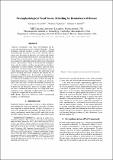Neurophysiological Vocal Source Modeling for Biomarkers of Disease
Author(s)
Ciccarelli, Gregory A.; Quatieri, Thomas F.; Ghosh, Satrajit S.
DownloadMain article (344.0Kb)
PUBLISHER_POLICY
Publisher Policy
Article is made available in accordance with the publisher's policy and may be subject to US copyright law. Please refer to the publisher's site for terms of use.
Terms of use
Metadata
Show full item recordAbstract
Speech is potentially a rich source of biomarkers for detecting and monitoring neuropsychological disorders. Current biomarkers typically comprise acoustic descriptors extracted from behavioral measures of source, filter, prosodic and linguistic cues. In contrast, in this paper, we extract vocal features based on a neurocomputational model of speech production, reflecting latent or internal motor control parameters that may be more sensitive to individual variation under neuropsychological disease. These features, which are constrained by neurophysiology, may be resilient to artifacts and provide an articulatory complement to acoustic features. Our features represent a mapping from a low-dimensional acoustics-based feature space to a high-dimensional space that captures the underlying neural process including articulatory commands and auditory and somatosensory feedback errors. In particular, we demonstrate a neurophysiological vocal source model that generates biomarkers of disease by modeling vocal source control. By using the fundamental frequency contour and a biophysical representation of the vocal source, we infer two neuromuscular time series whose coordination provides vocal features that are applied to depression and Parkinson’s disease as examples. These vocal source coordination features alone, on a single held vowel, outperform or are comparable to other features sets and reflect a significant compression of the feature space.
Date issued
2016-09Department
Lincoln Laboratory; Massachusetts Institute of Technology. Department of Electrical Engineering and Computer Science; McGovern Institute for Brain Research at MITJournal
Interspeech 2016: Conference Proceedings
Publisher
International Speech Communication Association
Citation
Ciccarelli, Gregory, Thomas F. Quatieri, and Satrajit S. Ghosh. "Neurophysiological Vocal Source Modeling for Biomarkers of Disease." In INTERSPEECH 2016: Understanding Speech Processing in Humans and Machines, Technical Program, San Francisco, Hyatt Regency, September 8-12, 2016.
Version: Author's final manuscript